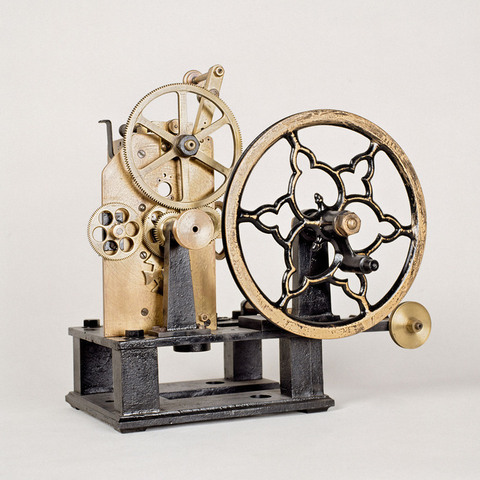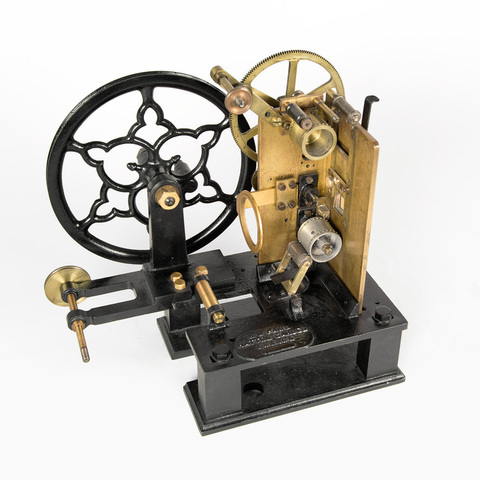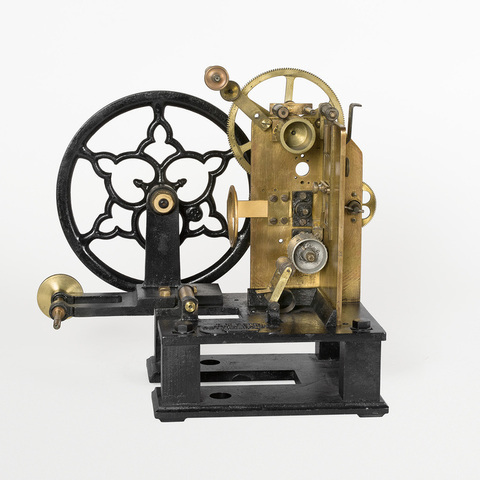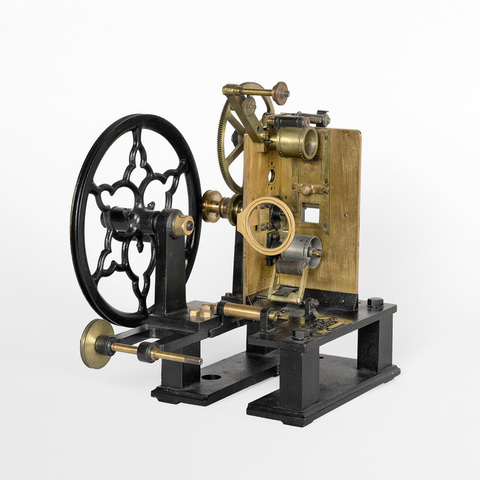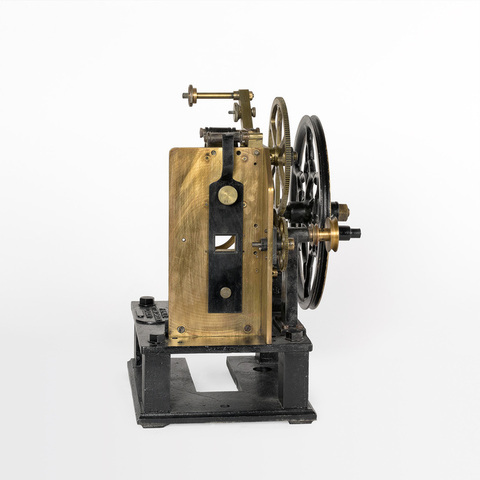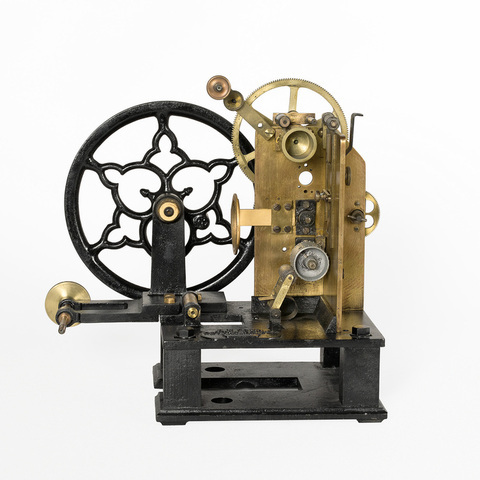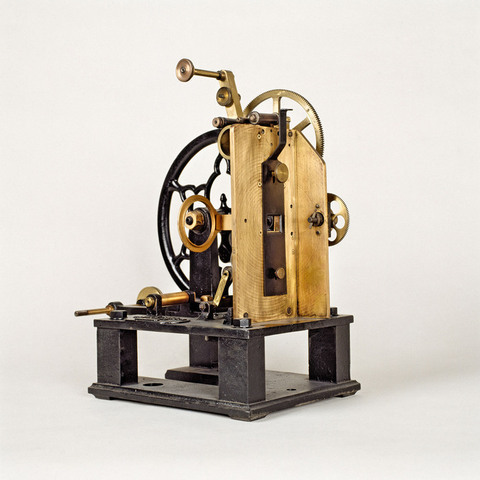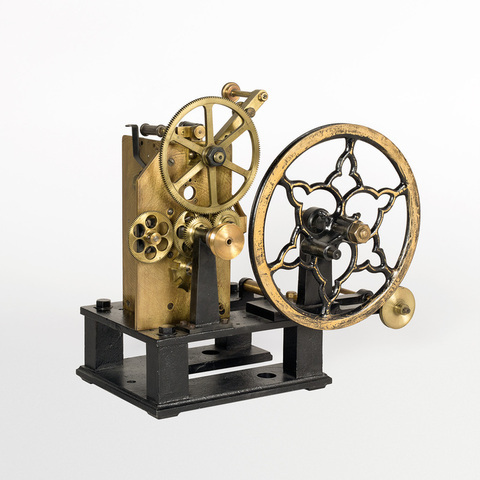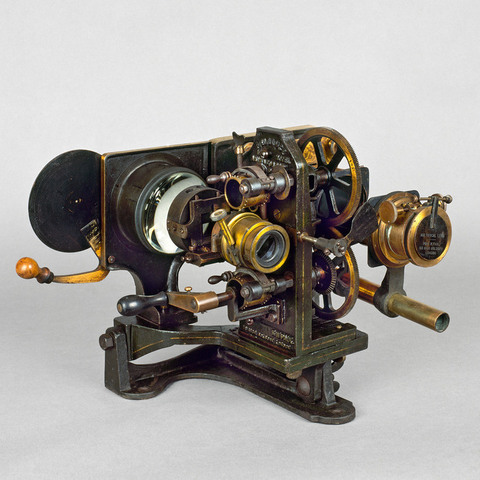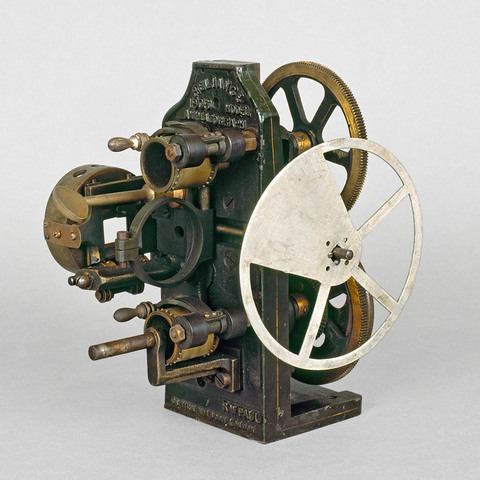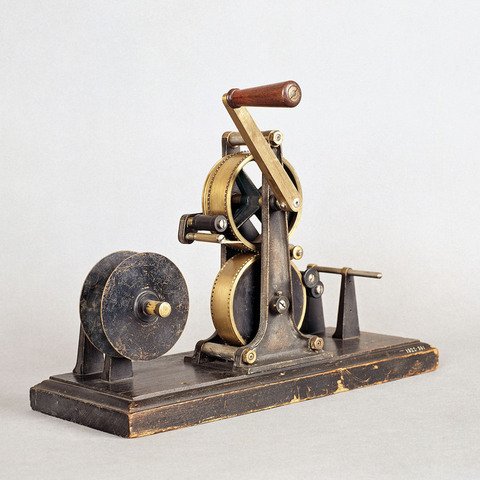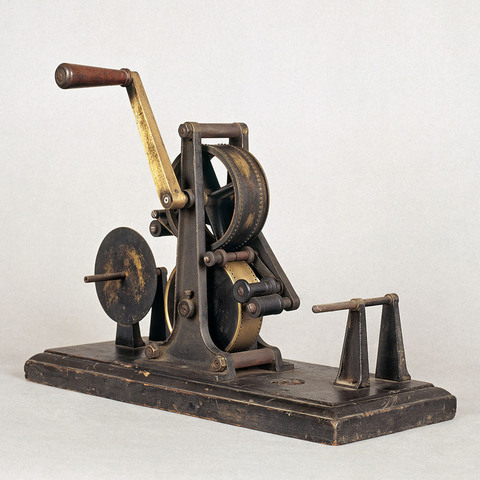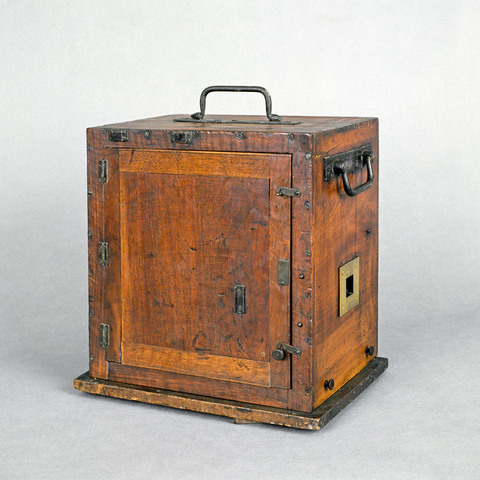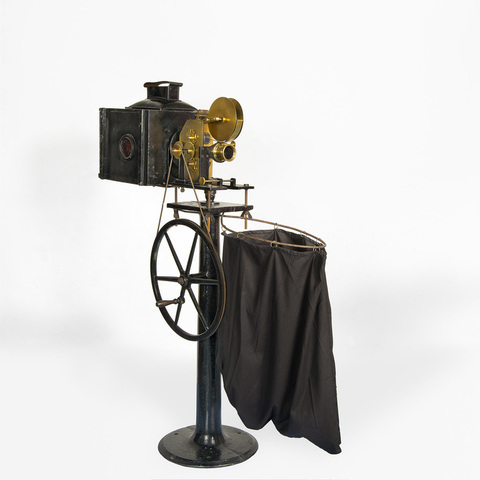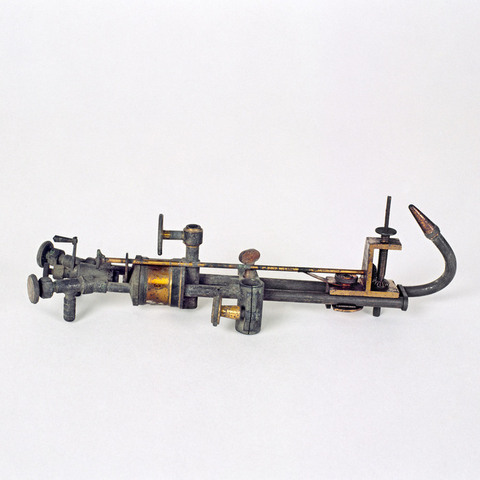Projecteur de film 35 mm
Fiche détaillée
Type de l'appareil
entraînement du film 35 mm par croix de Malte à sept branches ; deux débiteurs ; bras débiteur et récepteur ; roue d'entraînement ; porte-objectif
Auteurs
Paul Robert William
Londres, 44 Hatton Garden
Fabricants
Robert William Paul
Londres, 44 Hatton Garden
Utilisateurs
Paul Robert William
Londres, 44 Hatton Garden
Distributeurs
Informations non disponibles
Sujet du modèle
Informations non disponibles
Objectif
Informations non disponibles
Taille de l'objet
Ouvert :
Informations non disponibles
Fermé :
Longueur : 41 cm
Largeur : 28 cm
Hauteur : 42 cm
Diamètre :
Informations non disponibles
Taille de la boîte de transport
Informations non disponibles
Remarques
Moulé sur le socle en fonte : "R.W. Paul, Hatton Garden, London". Modèle modifié du premier Theatrograph : l'une des croix de Malte a été retirée ; le débiteur supérieur a été relevé. Voir modèle original : AP-95- 1748. Voir modèle transformé par Méliès : AP-95- 1450.
"R.W. Paul solution to the problem of film projection was speedily resolved, and his first projector was ready not later than 20 February 1896, when it was exhibited at the Finsbury Technical College. [...] A notice of Paul's first projector, which was called the Theatrograph, appeared in The English Mechanic for 21 February 1896. [...] It was clearly Paul's intention at this time to manufacture the Theatrograph projector for the commercial market. [La première version fonctionne avec une seule croix de Malte à sept branches et un débiteur]. The first Theatrograph projector was not patented, and no examples of it are known to be extant. [...] R. W. Paul, lecture to the BKS on 3 February 1936 : "I first adopted a modification of the familiar Geneva Stop, as used in watches, to give an intermittent motion to the sprocket. Because the 14-picture sprocket of the kinetoscope had to great an inertia I made one in aluminium, one-half its diameter. My first projector is described in The English Mechanic of February 21st and March 6th, 1896. It was intended to be sold at five pounds, and to be capable of attachment to any existing lantern. The seven-toothed star wheel was driven by a steel finger-wheel which acted also as a locking device during the period when the shutter was open. [...] A fault, which I ought to have foreseen, was the unsteadiness caused by the inertia of the spool of films, and it became necessary to insert the films, 40 or 80 feet long, singly. So this model, with I first saw a moving picture on the screen, was promptly scrapped". [...] We have conclusive evidence that it was used at the performances given at the Finsbury Technical College on 20 February, at the Royal Institution on 28 February, and at Olympia from 21 March. We have reason to believe that it may also have been used for a few performances at the Alhambra, Leicester Square, from 25 March, as well as at other theatres in London. The major defect of this first model, as Paul has pointed out, was the drag on the film caused by the weight of the top spool when overloaded with too much film. Since most of Paul's film subject at this period were either 40 or 80ft long, only one or two subjects could be laced in the machine at one time. This was a decided drawback as far as public exhibition was concerned and Paul set about designing a second model, also called the Theatrograph, which he patented on 2 March 1896 (n° 4686). From an examination of contemporary reviews of Paul's early film performances, we have reason to believe that it was not until the end of the following month that this second model had been manufactured in sufficient quantities to replace all the old ones then in use. Paul's first perfomance at the Alhambra took place on Wednesday, 25 March, and was written up in The Era the following Saturday. [...] The Era, 16th May : "Mr Paul has much improved his animated pictures presented by means of his clever invention. The finish of the Derby of 1895 excites enthusiasm nightly". [...] It is impossible to determine, from the evidence at present available, just how many examples of the first Theatrograph were manufactured, but it may be possible to account for six. If we accept the supposition that Paul's new model was not ready in sufficient numbers to replace all the old ones in use until the end of April, then it is reasonable to assume that some of the performances given before that date were with the first model. [...] Paul's second Theatrograph projector was patented on 2 March 1896 (n° 4686), a little more than a week after the first was exhibited at the Finsbury Technical College (20 February). Production of the first model had thus hardly got under way when Paul, realising its shortcomings, immediately set about designing this new machine. Although a marked improvement on the former, the second Theatrograph did not entirely satisfy Paul either and he later made several minor modifications to its design. In his BKS lecture, Paul related the sequence of improvements which he carried out after the first Theatrograph had been completed and found wanting : "The next steep consisted in duplicating the intermittent sprockets, the film being kept more or less taut between them. At that time the fact or liability to shrinkage in the film was not realised. The new mechanism had a revolving shutter in the form of a horizontal drum cut away in two opposite sides, and rewind spool was provided, driven by a splipping belt. A large hand wheel was belted to a small pulley on the finger-wheel spindle, the latter being coupled to the shutter spindle by spurs gears. This machine is illustrated in my Patent Specification of March 2nd, 1896, and was supplied with its lantern as a complete projector, either on an iron pillar or with a combined carrying case and strand. After a few of these projectors had been put into operation the need for larger spools, to contain a series of films, became evident. So additional sprockets were arranged to give continuous feed abowe and below the intermittent sprockets, and the masking device was improved. Of this model over 100 were produced, many being exported to the Continent and some to the United States. A precisely similar mechanism was used in the perforator and in the camera. An example of the camera of 1896, as used for taking many of my early films, is preserved in the Science Museum, together with the projector just described. These machines were decidedly noisy, an objection which was minimised by the fact that projection was usually from the back of the stage, through a translucent screen". [...] Carl Hertz, a well-known American conjurer and showman, was one of the very first to acquire one. In his autobiography, A Modern Mystery Merchant, Hertz relates the circumstances leading up to the acquisition of the first of the new machines. Paul was reluctant to part with it, and since Hertz was about to sail for his tour of South Africa and Australia, and was bent on taking the new machine with him, he unscrewed it from the floor, thrust £ 100 into Paul's hand and departed with it. However exaggerated this story may be, it does provide an approximate date for the completion of this model, for we know Hertz sailed for South Africa on 28 March 1896, and we also know that he took one of Paul's machine with him. This same Theatrograph projector, which one belonged to Carl Hertz, is claimed to be in the Will Day Collection of Historic Cinematograph and Moving Picture Equipment. Although the catalogue entry is inaccurate in other respects, there is no reason to doubt that the machine listed as item n° 129 is Hertz's actual machine. It is shown in the photograph reproduced in the catalogue as Plate 5a. Here it can be seen on the top shelf of the show-case exhibited at the Science Museum, where it was once on loan. The apparatus is shown complete with its lantern, but without the iron pillard. The machine, it will be remembered, was supplied either on an iron pillar or with a combined carrying case which also served as a projection stand. The latter would, of course, be the more convenient arrangement for Hertz's purposes, since he had to take it with him on his various travels, and lightness and portability were factors to be considered. I have not had the opportunity of examining the actual apparatus, but a study of the photograph in the Will Day catalogue clearly shows it to be the first pattern, since there is no indication of the additional sprockets which Paul says were added in the modified version to provide a continuous feed to the film above and below the two intermittent sprockets. It should be noted that the provision for additional sprockets was made in the complete specification which was not deposited with the Patent Office until 30 November 1896. Paul's second Theatrograph projector is also illustrated in The Strand Magazine for August 1896, where it is the first pattern that is again shown. A comparison with the model in the Will Day collection shows only a difference in the lantern. The one shown in the Strand photograph has a short cylindrical chimney surmounted by a rose-type cowl, whereas that in the Will Day photograph has an oblong cowl with a slightly curved top. [...] Be this as it may, the projection mechanism is identical in both cases. A similar projector, donated by R. W. Paul, is in the Science Museum, South Kensington, but is incomplete, although the missing parts have been replaced by replicas copied from the machine in the Will Day Collection at the time the latter was on loan to the museum. The replica parts include the lamphouse or lantern, driving handle, film spool and optical system. [...] Paul also states that improvements were made to the masking device, ie the picture rack adjustment. Although Paul says that over 100 of this model were produced, we have not been able to trace a single example. There exists, however, a variation of this projector, which has a single continuous-feed sprocket placed above the two intermittent sprockets but without the second lower one described in Paul's complete specification. The projector is preserved at the Cinémathèque française in Paris, and although it is incomplete enough remains to indicate the features in question. Whether or not a second modification was subsequently made to incorporate two continuous-feed sprockets as indicated in the patent has not been established and it is a matter for conjecture whether indeed such a model was ever produced" (John Barnes, The Beginnings of the cinema in England, Londres, David & Charles, 1976, p. 19-56, 116-124).
Bibliographie
Will Day, "An Early Chapter of Kinematograph History", Kinematograph Year Book, 1914, p. 43-48.
Will Day, Illustrated Catalogue of the Will Day Historical Collection, Londres, s.d., [1934].
John Barnes, The Beginnings of the Cinema in England, Londres, David & Charles, 1976.
